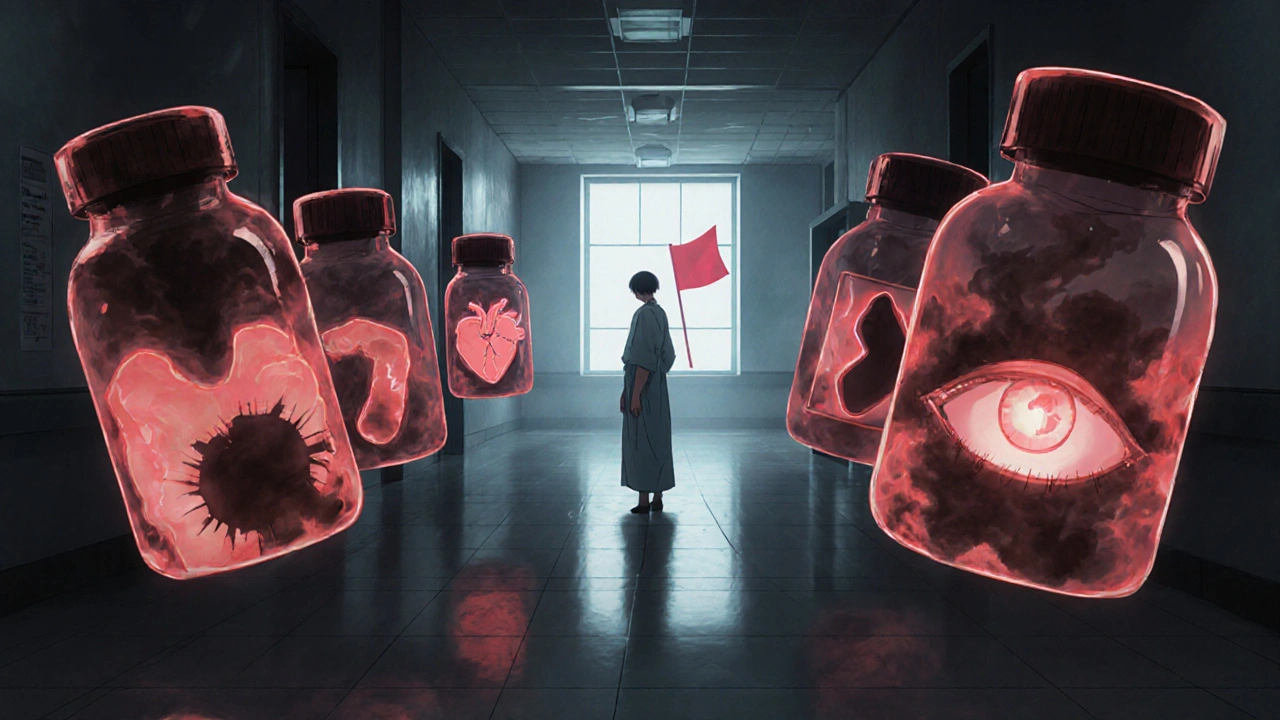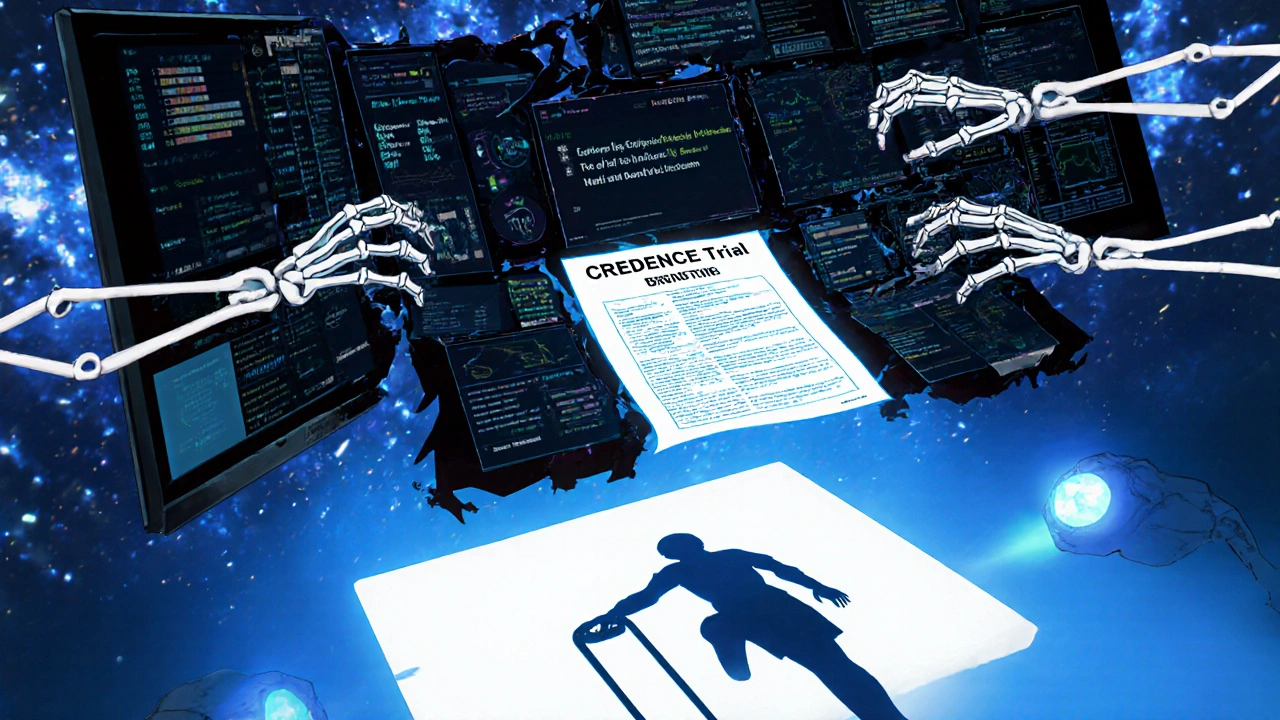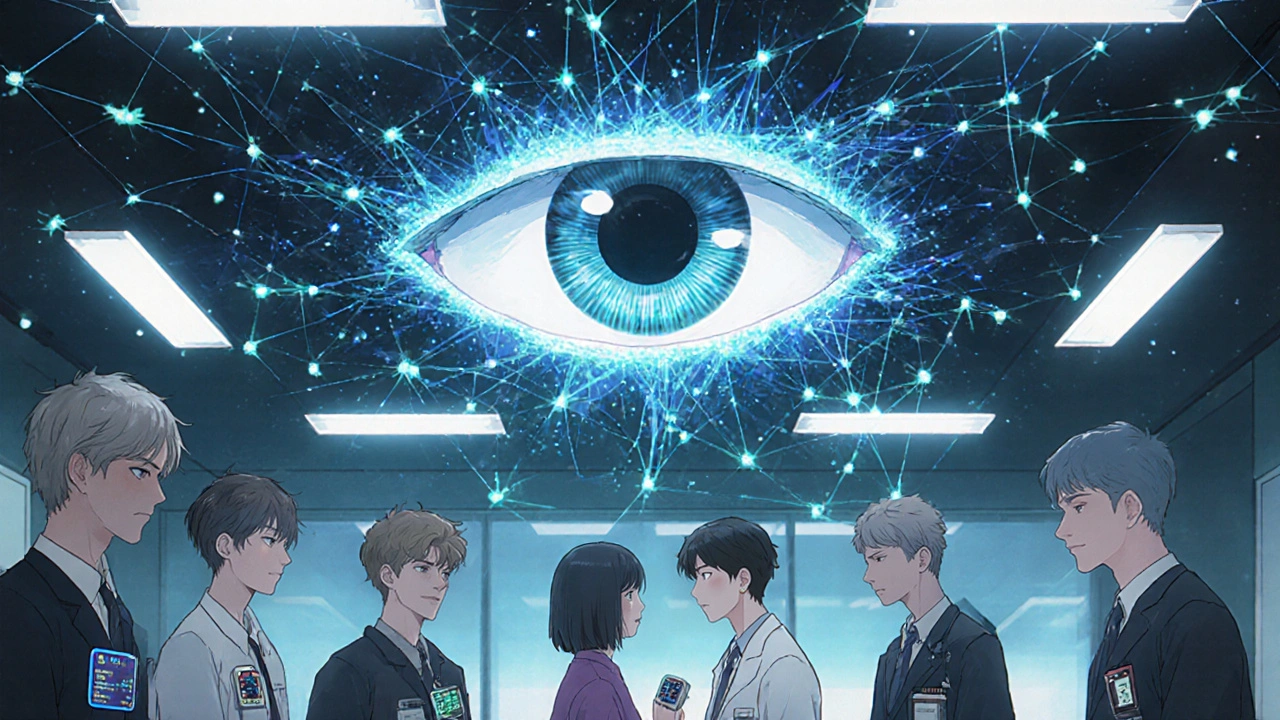Drug Safety Signals and Clinical Trials: How Hidden Risks Emerge After Approval
 Nov, 10 2025
Nov, 10 2025
When a new drug hits the market, everyone assumes the worst risks are already known. Clinical trials test thousands of people over months or a few years. But real life? Millions take the drug for years. That’s where the real dangers hide.
What Exactly Is a Drug Safety Signal?
A drug safety signal isn’t just a rumor or a single complaint. It’s a pattern - something that pops up enough times across different sources to make regulators pause and ask: could this drug be causing this?
The Council for International Organizations of Medical Sciences (CIOMS) defines it clearly: a signal is information suggesting a new or unexpected link between a medicine and an adverse event that’s strong enough to warrant investigation. It’s not proof. It’s a red flag. And those flags don’t come from lab tests or animal studies. They come from real people - patients, doctors, and pharmacies reporting side effects after the drug is already out in the wild.
Think of it this way: clinical trials are like testing a car on a closed track. You check the brakes, the engine, the steering. But you don’t know how it handles in a snowstorm, with a driver who’s tired, or after someone adds the wrong kind of fuel. That’s what happens after approval. The real world is messy. And that’s where signals emerge.
How Clinical Trials Miss the Big Risks
Clinical trials are designed to prove a drug works - not to catch every possible side effect. Most trials enroll between 1,000 and 5,000 people. They last months, not years. Participants are carefully selected: no major health problems, no other medications, no pregnancy. They’re healthy enough to be in a trial - not representative of the real patient population.
That means rare side effects? They’re invisible. If a side effect happens in 1 in 10,000 people, you’d need 40,000 patients to have a decent shot at spotting it. Most trials don’t get there. And if it takes five years to show up? The trial’s long over.
Take the diabetes drug canagliflozin. Early trials showed a slight increase in foot ulcers. But the real risk - lower-limb amputations - didn’t become clear until after 1.9 million prescriptions were filled. The signal emerged from spontaneous reports, not the trial data. The FDA flagged it in 2017. By 2020, the CREDENCE trial confirmed it: a 0.5% absolute increase in amputations. That’s small. But for the patients affected? It’s everything.
Where Signals Come From - Beyond the Trial Data
Most signals come from spontaneous reporting systems. That’s where patients or doctors voluntarily report side effects to regulators. The FDA’s FAERS database has over 30 million reports since 1968. The EMA’s EudraVigilance handles more than 2.5 million new reports every year.
These reports are messy. They’re incomplete. Sometimes they’re wrong. But they’re the only window we have into what happens when a drug is used by millions - with diabetes, kidney disease, heart conditions, and a dozen other pills in their medicine cabinet.
Regulators don’t just look at individual reports. They use statistics. Disproportionality analysis. Bayesian methods. Proportional reporting ratios. These tools compare how often a side effect is reported with a specific drug versus how often it shows up with other drugs. If a certain reaction pops up 3 or 4 times more often with Drug A than with others? That’s a signal.
But here’s the catch: 60% to 80% of these statistical signals turn out to be false alarms. A 2019 signal linked canagliflozin to amputations based on FAERS data with a reporting odds ratio of 3.5. It looked terrifying. But when the real-world trial data came in, the actual risk was tiny. That’s why experts say: don’t trust one source. Triangulate. Look for the same pattern in electronic health records, patient registries, scientific literature, and other databases.

What Makes a Signal Turn Into a Warning?
Not every signal leads to a label change. But some do. And when they do, it’s because they hit four key criteria:
- Replication across sources - The same signal appears in FAERS, EudraVigilance, and a published study. That’s powerful. Studies show this makes a label update 4.3 times more likely.
- Biological plausibility - Does the mechanism make sense? Rosiglitazone was linked to heart attacks in 2007. That wasn’t random. It was a known effect on blood vessel function.
- Severity - Serious events (hospitalization, death, disability) are 2.7 times more likely to trigger a warning than mild ones. A rash? Maybe a footnote. A liver failure? Full warning.
- Drug age - New drugs (under 5 years on the market) are 2.3 times more likely to get updated labels than older ones. That’s because we’re still learning.
Take dupilumab, a psoriasis and eczema drug. In 2018, ophthalmologists started noticing a pattern: patients on the drug were developing severe eye inflammation. The signal came from spontaneous reports. Then, European doctors confirmed it. By 2019, the label was updated. Doctors now screen for eye issues before prescribing. That’s signal detection working - fast, and saving vision.
The System Isn’t Perfect - And Here’s Why
Even with billions spent and advanced AI tools, the system still struggles.
First, reporting is biased. Serious events are reported 3.2 times more often than mild ones. Minor rashes? Often ignored. That skews the data.
Second, causality is hard. Did the drug cause the reaction? Or was it the patient’s other meds? Their age? Their genetics? Spontaneous reports rarely have enough detail to say for sure. That’s why follow-up is critical - and often missing. A 2022 survey found 68% of safety officers say poor data quality is their biggest headache.
Third, some dangers take years. Bisphosphonates - osteoporosis drugs - were linked to jawbone death in 2003. But the first cases appeared 7 years after the drug was approved. The signal was there. But no one connected the dots until it was too late for many patients.
And now, with more elderly patients on five or six drugs at once, the system is overwhelmed. Polypharmacy creates combinations no one ever tested. A 2022 study found 400% more prescriptions for seniors since 2000. Our signal detection tools weren’t built for this.

How the System Is Evolving - And What’s Next
Regulators aren’t sitting still.
The FDA’s Sentinel Initiative 2.0, launched in 2023, pulls data from 300 million patients across 150 health systems. It’s not just reports anymore - it’s real-time electronic health records. That means spotting a spike in kidney injury linked to a new blood pressure drug within weeks, not years.
The EMA started using AI in EudraVigilance in late 2022. Signal detection time dropped from 14 days to 48 hours. Sensitivity stayed at 92%. That’s a game-changer.
Drug companies are also adapting. The ICH’s M10 guideline, coming in 2024, will standardize how lab results from liver function tests, kidney markers, and blood counts are reported. That’s huge for catching drug-induced liver injury - one of the most common reasons drugs get pulled.
And the future? It’s integrated. By 2027, 65% of high-priority signals will come from combining spontaneous reports, EHRs, wearable data, and even patient apps. Imagine a diabetic patient using a glucose monitor that also logs nausea and dizziness. That data could feed directly into a safety system - flagging a pattern before a single doctor even reports it.
What This Means for Patients and Doctors
As a patient, don’t assume your drug is 100% safe just because it’s been on the market for years. Side effects can emerge years later. If you notice something new - especially if it’s serious or unusual - report it. Your report could be the next signal that saves someone else.
As a doctor, don’t ignore subtle symptoms. A mild headache, a change in vision, an unexplained rash - they might not seem like much. But if multiple patients report the same thing with the same drug? That’s your early warning.
And for everyone: trust the system, but understand its limits. Drug safety isn’t a one-time check. It’s a lifelong watch. The science is better than ever. But it still needs you - your observations, your reports, your voice - to work.
How to Spot a Real Signal - A Quick Guide
Not every odd reaction means danger. But here’s how to tell the difference:
- Is it new? Not listed in the patient leaflet? That’s a red flag.
- Is it repeated? Same symptom in multiple people on the same drug?
- Is it serious? Hospitalization, disability, or death?
- Is there a time link? Did the symptom start within days or weeks of starting the drug?
- Did it go away when the drug was stopped? (Dechallenge)
- Did it come back when restarted? (Rechallenge)
If you see 3 or more of these, it’s worth reporting - even if you’re not sure. Regulators don’t expect you to be an expert. They just need the data.
What’s the difference between a side effect and a safety signal?
A side effect is any unwanted reaction to a drug - even if it’s common and known. A safety signal is a pattern of previously unknown or unexpected reactions that suggests a possible new risk. One is an event. The other is a trend that needs investigation.
Can a drug be pulled from the market because of a safety signal?
Yes - but it’s rare. Most signals lead to label updates, new warnings, or restricted use. Full withdrawal usually happens only when the risk clearly outweighs the benefit and no safer alternative exists. Examples include fenfluramine (heart valve damage) and rosiglitazone (heart attack risk), which were severely restricted.
How long does it take for a signal to become a label change?
It varies. Simple cases with strong evidence can take 6-12 months. Complex ones, especially if the signal is controversial or data is conflicting, can take 2-5 years. The median time for a full assessment is 3-6 months, but regulatory review adds more.
Why do some signals turn out to be false?
Because correlation isn’t causation. A side effect might be common in the population - like headaches or nausea - and happens to occur in people taking the drug by coincidence. Other times, reporting bias or poor data quality creates false patterns. That’s why regulators require multiple lines of evidence before acting.
Are newer drugs more dangerous than older ones?
Not necessarily. But they’re less understood. Older drugs have been used by millions over decades - their risks are mostly known. Newer drugs have only been tested on a few thousand people. So while they’re not inherently more dangerous, they carry more unknowns. That’s why they get more label updates in the first 5 years.

vanessa k
November 11, 2025 AT 00:58The canagliflozin amputation risk still haunts me. I had a cousin on it-never told his doctor about the foot numbness until it was too late. No one thinks to connect the dots until it’s a stump.
Doctors act like side effects are just ‘expected noise.’ They’re not. They’re whispers. And if you ignore enough whispers, someone dies.
Report everything. Even if it seems minor. Even if you’re not sure. Someone’s life might depend on your ‘overreaction.’
manish kumar
November 11, 2025 AT 20:29Let me tell you something about signal detection that nobody talks about-the system is built on the backs of exhausted patients and overworked pharmacists who stay late to fill out forms no one reads. The FDA gets millions of reports, but how many are just people Googling symptoms and panicking? And how many are legitimate? The stats don’t care about context.
When I worked in a rural clinic, a woman came in with a rash after starting a new statin. We didn’t report it because the doctor said, ‘It’s probably just laundry detergent.’ Two months later, she was hospitalized with Stevens-Johnson. That’s the gap. Not bad science. Bad systems.
We need AI, yes, but we also need to pay people to actually read these reports. Not just count them.
And stop pretending that ‘biological plausibility’ is some magic filter. Sometimes the body just breaks in ways we don’t understand yet. That doesn’t mean it’s not real.
Nicole M
November 13, 2025 AT 12:28So wait-so if a drug causes liver damage in 1 in 50,000 people, and we only test 5,000 people in trials… we’re basically gambling with 90% of the population’s safety? That’s not science. That’s capitalism with a lab coat.
And don’t even get me started on how drug companies bury negative data. I read a paper once where a trial was stopped early for safety concerns… but the company didn’t report it until 3 years later, after the drug was already on the market.
Why are we still trusting this system? We shouldn’t be. We should be screaming.
Arpita Shukla
November 14, 2025 AT 20:06You all keep talking about signals like they’re some new phenomenon. They’re not. This has been going on since thalidomide. The difference now is we have more data-but not better judgment.
FAERS is a dumpster fire. People report ‘headache’ after taking aspirin. That’s not a signal. That’s a census.
And the ‘biological plausibility’ criterion? That’s just confirmation bias dressed up as science. If you can’t explain it mechanistically, you ignore it? That’s how we missed the link between estrogen and breast cancer for decades.
Real safety isn’t about statistics. It’s about humility. Admit we don’t know. Stop pretending algorithms can replace clinical intuition.
And for God’s sake, stop calling patients ‘reporters.’ They’re not data points. They’re people.
Benjamin Stöffler
November 15, 2025 AT 03:33Let me be perfectly clear: the entire pharmacovigilance infrastructure is a grotesque, over-engineered, underfunded, bureaucratic farce-designed not to protect patients, but to protect shareholders from liability!
When you say ‘triangulate data,’ you’re really saying ‘wait until enough people die before we act.’
And don’t even get me started on the ‘false alarm’ myth-60% to 80%? That’s not noise-that’s negligence. If your fire alarm goes off 80% of the time, you don’t disable it-you fix the wiring!
And yet, regulators treat every signal like a prank call. Meanwhile, patients are dying from ‘rare’ events that are only rare because we refuse to look hard enough.
It’s not a failure of data-it’s a failure of will.
And the worst part? The same people who wrote the guidelines are still in charge.
They’re not broken. They’re broken by design.
Mark Rutkowski
November 16, 2025 AT 20:40There’s a quiet tragedy here that no one wants to name: we treat drugs like they’re immutable truths, not living, evolving risks.
Every pill we take is a pact between science and uncertainty. We’re not just taking medicine-we’re trusting strangers we’ve never met, in labs we’ve never seen, with data we’ll never fully understand.
And yet, we expect perfection.
Maybe the real danger isn’t the drugs.
Maybe it’s the illusion that we’ve tamed nature.
The body doesn’t obey trial protocols. It doesn’t care about p-values or confidence intervals.
It just reacts.
And if we’re lucky, someone notices.
So report the weird stuff.
Speak up.
Even if it feels like shouting into a hurricane.
Because someone, somewhere, is listening-and their silence might be the only thing standing between you and disaster.
Ryan Everhart
November 17, 2025 AT 09:39So… we spend billions on AI to detect signals that are mostly false alarms, while ignoring the fact that 70% of patients never report side effects because they don’t think it matters?
And you’re surprised the system’s broken?
It’s not broken. It’s just lazy.
Also, ‘biological plausibility’? That’s just science’s way of saying ‘I don’t like this, so I’m gonna pretend it’s not real.’
Next you’ll tell me we shouldn’t worry about long-term opioid use because ‘it’s not mechanistically plausible’ that painkillers cause depression.
Yeah. Right.
Just report the damn thing. We’ll figure out the rest later.
David Barry
November 18, 2025 AT 01:42Let’s cut the crap. The entire post is a PR piece disguised as journalism.
Yes, signals emerge after approval. So what? That’s the business model.
Drugs are approved on the flimsiest data possible because the market demands them yesterday.
Then, when the side effects roll in? ‘Oh, we didn’t see that!’
Meanwhile, the company’s stock is up 30% and the CEO’s bonus is secured.
Regulators? They’re not watchdogs. They’re speed bumps.
And patients? They’re the collateral damage in a $1.5 trillion industry that treats human bodies like beta testers.
Stop romanticizing ‘signal detection.’ It’s damage control.
And it’s always too late.
Alyssa Lopez
November 19, 2025 AT 07:15Look, I get it, but we’re talking about American patients here-this isn’t some third-world country. We have the best regulatory system in the world.
FAERS? EudraVigilance? Sentinel? These are cutting-edge tools that no other nation has.
And yes, some signals turn out false-but that’s because people are dumb and report everything from ‘feeling weird’ to ‘my cat died.’
Also, the real issue is that patients don’t follow instructions. They take meds with grapefruit juice. They mix with OTC stuff. They don’t tell their doctors.
Stop blaming the system. Blame the people who won’t read the label.
And stop using ‘biological plausibility’ as a buzzword. It’s science, not magic.
Also, ‘polypharmacy’? That’s not the drug’s fault. That’s the doctor’s fault for prescribing 7 meds to an 80-year-old.
Fix the system? Nah. Fix the users.
edgar popa
November 20, 2025 AT 02:49My grandma took metformin for 12 years. Never had a problem. Then outta nowhere-lactic acidosis. They didn’t know why. She didn’t even know to report the fatigue.
Just… report stuff. Even if you think it’s nothing.
It might save someone.